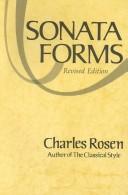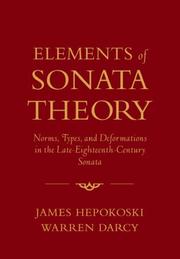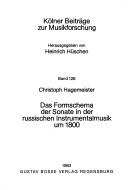| Listing 1 - 8 of 8 |
Sort by
|

ISBN: 0393012034 0393302199 Year: 1988 Publisher: New York (N.Y.) : Norton,
Abstract | Keywords | Export | Availability | Bookmark
 Loading...
Loading...Choose an application
- Reference Manager
- EndNote
- RefWorks (Direct export to RefWorks)
Sonata form. --- Forme sonate --- Sonata form --- Sonatevorm --- 513 --- Muziekanalyse - vormleer --- Sonata-allegro form --- Musical form
Book
ISBN: 9780521762540 0521762545 9780521756310 0521756316 9780511974298 9781107313866 1107313864 0511974299 9781107308312 1107308313 9781107306110 1107306116 1107301033 9781107301030 1107216842 9781107216846 1107253543 9781107253544 1299276296 9781299276291 1107311667 9781107311664 Year: 2011 Publisher: Cambridge, UK New York Cambridge University Press
Abstract | Keywords | Export | Availability | Bookmark
 Loading...
Loading...Choose an application
- Reference Manager
- EndNote
- RefWorks (Direct export to RefWorks)
What is a sonata? Literally translated, it simply means 'instrumental piece'. It is the epitome of instrumental music, and is certainly the oldest and most enduring form of 'pure' and independent instrumental composition, beginning around 1600 and lasting to the present day. Schmidt-Beste analyses key aspects of the genre including form, scoring and its social context - who composed, played and listened to sonatas? In giving a comprehensive overview of all forms of music which were called 'sonatas' at some point in musical history, this book is more about change than about consistency - an ensemble sonata by Gabrieli appears to share little with a Beethoven sonata, or a trio sonata by Corelli with one of Boulez's piano sonatas, apart from the generic designation. However, common features do emerge, and the look across the centuries - never before addressed in a single-volume survey - opens up new and significant perspectives.
Sonata. --- Sonata form. --- Sonata-allegro form --- Musical form --- Sonata --- Sonatas --- Sonatina --- History and criticism

ISBN: 0195146409 9780195146400 1282270702 0198033451 9786612270703 1429420499 0199773912 0199850984 Year: 2006 Publisher: Oxford [etc.] Oxford University Press
Abstract | Keywords | Export | Availability | Bookmark
 Loading...
Loading...Choose an application
- Reference Manager
- EndNote
- RefWorks (Direct export to RefWorks)
This book analyses the sonata. Both building on and departing from earlier methods of analysis, it provides an in-depth examination of the sonata genre. After establishing the normative features of the sonata, the authors examine how individual sonatas from Beethoven, Haydn, and Mozart both adhere to and deviate from those standards to a variety of effects. Co-authored by a music theorist and a musicologist, the book provides a foundational theory and offers insights on individual works from the Western canon.
Sonata form. --- Forme sonate --- Instrumental music --- Analysis, appreciation --- Analysis, appreciation. --- Sonata form --- Sonata-allegro form --- Musical form --- Music, Instrumental --- Music
Multi
ISSN: 07213611 ISBN: 3906754502 Year: 1996 Volume: 156 Publisher: Bern ; New York ; Wien Peter Lang
Abstract | Keywords | Export | Availability | Bookmark
 Loading...
Loading...Choose an application
- Reference Manager
- EndNote
- RefWorks (Direct export to RefWorks)
Sonata --- Sonate --- Sonata form --- Forme sonate --- Schubert, Franz, --- Sonata-allegro form --- Musical form --- Schubert, Franz --- Criticism and interpretation --- Muziekanalyses --- Vormen --- Romantiek --- 19e eeuw --- Oostenrijk --- Schubert, Franz (1797-1828)

ISBN: 376492263X Year: 1983 Publisher: Regensburg Bosse
Abstract | Keywords | Export | Availability | Bookmark
 Loading...
Loading...Choose an application
- Reference Manager
- EndNote
- RefWorks (Direct export to RefWorks)
Instrumental music --- Sonata form --- Sonata-allegro form --- Musical form --- Music, Instrumental --- Music --- Analysis, appreciation --- muziekanalyse --- sonaten --- muziekgeschiedenis --- anno 1700-1799 --- anno 1800-1899 --- Russia
Book
ISBN: 0199747180 0199987300 9780199987306 9780199747184 9780199987290 0199987297 Year: 2013 Publisher: New York
Abstract | Keywords | Export | Availability | Bookmark
 Loading...
Loading...Choose an application
- Reference Manager
- EndNote
- RefWorks (Direct export to RefWorks)
Analyzing Classical Form builds upon the foundations of the author's critically acclaimed Classical Form by offering an approach to the analysis of musical form that is especially suited for classroom use. Providing ample material for study in both undergraduate and graduate courses, Analyzing Classical Form presents the most up-to-date version of the author's ""theory of formal functions."" Students will learn how to make complete harmonic and formal analyses of music drawn from the instrumental works of Haydn, Mozart, and Beethoven. Part 1 introduces the principal theme-types of classical in
Musical form --- Sonata form. --- Musical analysis. --- Classicism in music. --- Style, Musical --- Analysis, Musical --- Analytical guides (Music) --- Hermeneutics (Music) --- Music --- Music analysis --- Music theory --- Music appreciation --- Sonata-allegro form --- Form, Musical --- Analysis, appreciation --- Analytical guides --- Instruction and study
Book
ISBN: 9789058677518 9058677516 9789461660145 9461660146 Year: 2009 Publisher: Leuven Leuven University Press
Abstract | Keywords | Export | Availability | Bookmark
 Loading...
Loading...Choose an application
- Reference Manager
- EndNote
- RefWorks (Direct export to RefWorks)
Two-Dimensional Sonata Form is the first book dedicated to the combination of the movements of a multimovement sonata cycle with an overarching single-movement form that is itself organized as a sonata form. Drawing on a variety of historical and recent approaches to musical form (e.g., Marxian and Schoenbergian Formenlehre, Caplin's theory of formal functions, and Hepokoski and Darcy's Sonata Theory), it begins by developing an original theoretical framework for the analysis of this type of form that is so characteristic of the later nineteenth and early twentieth century. It then offers an in-depth examination of nine exemplary works by four Central European composers: the Piano Sonata in B minor and the symphonic poems Tasso and Die Ideale by Franz Liszt, Richard Strauss's tone poems Don Juan and Ein Heldenleben, the symphonic poem Pelleas und Melisande, the First String Quartet and the First Chamber Symphony by Arnold Schoenberg, and Alexander Zemlinsky's Second String Quartet.
muziekanalyse --- muziektheorie --- Music --- sonatenvorm --- Forme sonate --- Sonata form --- Sonatevorm --- 78.08 --- Academic collection --- Muzikale vormen --- Instrumental music --- Sonata form. --- Analysis, appreciation. --- Instrumental music -- Analysis, appreciation. --- Music, Dance, Drama & Film --- Music Instruction & Study --- Analysis, appreciation --- 78.08 Muzikale vormen --- Sonata-allegro form --- Musical form --- Zemlinsky, Alexander von. 1871-1942 --- Zemlinsky, Alexander
Book
ISBN: 9780199987290 9780199747184 0199987297 Year: 2013 Publisher: New York: Oxford university press,
Abstract | Keywords | Export | Availability | Bookmark
 Loading...
Loading...Choose an application
- Reference Manager
- EndNote
- RefWorks (Direct export to RefWorks)
Building upon the foundations of his critically acclaimed Classical Form, William E. Caplin’s Analyzing Classical Form presents the most up-to-date version of his "theory of formal functions" in an approach especially suited to the classroom. Students on both undergraduate and graduate levels will learn to construct complete harmonic and formal analyses of music drawn from the instrumental works of Haydn, Mozart, and Beethoven. Part 1 introduces the principal theme-types of classical instrumental music; part 2 provides a methodology for analyzing sonata form, the most important formal type in this style period; and part 3 considers other full-movement forms found in this repertory (such as minuet, rondo, and concerto). The book is amply illustrated with annotated musical examples for each topic covered, as well as many unannotated examples that can be used for in-class discussion and for out-of-class analytical exercises. A complete glossary of terms and chapter-by-chapter review questions will help students assimilate the many theoretical concepts employed in the book. A companion website provides audio and musical scores for all of the examples in the book as well as additional examples for the analysis of the simple theme-types presented in part 1.
Musical form --- Sonata form. --- Musical analysis. --- Classicism in music. --- Formes musicales --- Forme sonate --- Analyse musicale --- Classicisme dans la musique --- Classicism in music --- Musical analysis --- Sonata form --- Style, Musical --- Form, Musical --- Music --- Analysis, Musical --- Analytical guides (Music) --- Hermeneutics (Music) --- Music analysis --- Music theory --- Music appreciation --- Sonata-allegro form --- Analysis, appreciation --- Analytical guides --- Instruction and study
| Listing 1 - 8 of 8 |
Sort by
|

 Search
Search Feedback
Feedback About UniCat
About UniCat  Help
Help News
News